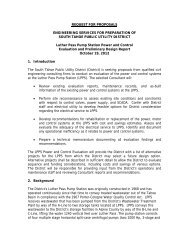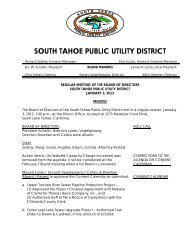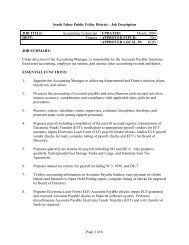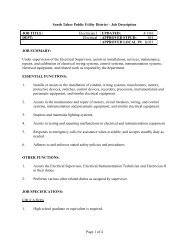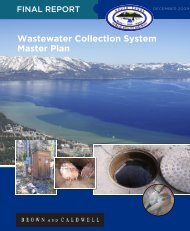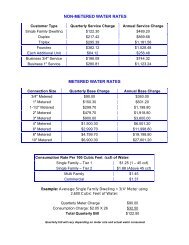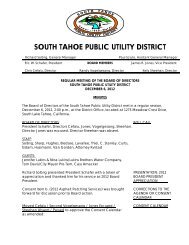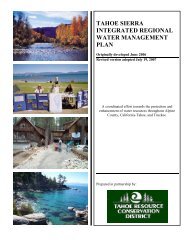October 2009 - South Tahoe Public Utility District
October 2009 - South Tahoe Public Utility District
October 2009 - South Tahoe Public Utility District
Create successful ePaper yourself
Turn your PDF publications into a flip-book with our unique Google optimized e-Paper software.
It is recommended that <strong>District</strong> implement Project No. 14, Snowshoe Thompson Ditch No. 1<br />
Conveyance Capacity Improvements, and Project No. 15, Upper Dressler Ditch Conveyance<br />
Improvements if additional freshwater flow to the Indian Creek Reservoir is deemed necessary<br />
and the <strong>District</strong> has a difficult time meeting its water surface elevation requirements at Indian<br />
Creek Reservoir. The additional freshwater flow may be needed if the current oxygenation<br />
project does not meet Indian Creek Reservoir TMDLs, or if contingent Project No. 19, Use Mud<br />
Lake Winter Flows for Indian Creek Reservoir Flushing, or contingent Project No. 20, Storage of<br />
Water for Downstream Users, are implemented in the future.<br />
2) Implement Project No. 18, Indian Creek Reservoir Spillway Channel<br />
It is recommended the <strong>District</strong> implement Project No. 18, Indian Creek Reservoir Spillway<br />
Channel if it is determined that a Probable Maximum Flood would cause a domino effect spill<br />
from the Indian Creek Reservoir and the Harvey Place Reservoir.<br />
13.9.5.4 Freshwater Management Contingent Projects<br />
1) Evaluate Drainage Conditions Prior to Project No. 15 Implementation<br />
An estimate of the total quantity of runoff produced by the watershed area above the Upper<br />
Dressler Ditch is recommended if Project No. 15, Upper Dressler Ditch Conveyance<br />
Improvements, is implemented. If a pipeline replaces portions of the existing Upper Dressler<br />
Ditch, storm runoff to Harvey Place Reservoir will increase and may potentially reduce its<br />
storage capacity.<br />
13.9.5.5 Groundwater Contingent Recommendations<br />
1) Conduct Tracer Study<br />
It is recommended the <strong>District</strong> conduct a caffeine tracer study if the need arises to differentiate<br />
between nitrate concentration in the groundwater from the <strong>District</strong>'s recycled water used in<br />
irrigation practices, and the nitrate concentration resulting from cattle grazing and other sources.<br />
A caffeine tracer study would separate out anthropogenic nitrates (those produced by humans)<br />
from those resulting from cattle and other natural sources. The study should be conducted in the<br />
Nevada/California border area and in areas where higher concentrations of nitrate are found. It<br />
is also recommended that monitoring wells be installed further down gradient of recycled water<br />
application areas to determine how quickly nitrates attenuate through dilution with groundwater.<br />
<strong>South</strong> <strong>Tahoe</strong> <strong>Public</strong> <strong>Utility</strong> <strong>District</strong><br />
Recycled Water Facilities Master Plan - <strong>October</strong> <strong>2009</strong> Page 13-107



